Introduction
In the realm of cybersecurity, firewalls stand as a fundamental line of defense, crucial for protecting sensitive information and maintaining the integrity of networks. As organizations navigate the complexities of an increasingly digital landscape, understanding the multifaceted roles that firewalls play becomes imperative.
From blocking unauthorized access to facilitating compliance with regulatory standards, these security devices are evolving to meet contemporary threats. With the rise of advanced technologies such as artificial intelligence and machine learning, the capabilities of firewalls are expanding, allowing for more robust protection against sophisticated cyber attacks.
This article delves into the various types of firewalls, their essential benefits, and the future trends shaping their development, providing a comprehensive overview of their critical role in modern security strategies.
Understanding Firewalls: Definition and Core Functions
A firewall is a crucial security device that illustrates the benefits of firewalls by monitoring and controlling both incoming and outgoing traffic based on established security protocols. The primary role of firewalls is to create a protective barrier between a trusted internal network and untrusted external networks, illustrating the benefits of firewalls. Firewalls can be categorized as hardware-based, software-based, or a hybrid of the two, serving as a pivotal defense mechanism against the ever-evolving landscape of cyber threats.
By effectively filtering traffic, they are capable of blocking malicious attacks and preventing unauthorized access to sensitive data, which showcases the benefits of firewalls in ensuring that only legitimate traffic is permitted. Recent studies suggest that the protective barrier market keeps expanding, fueled by rising awareness of safety requirements, particularly considering that around 5,600 ransomware events were recorded between January 2023 and February 2024. Moreover, as organizations increasingly recognize the importance of cybersecurity, expert opinions highlight that 69% of businesses view AI as a necessary component in their strategy to respond to cyber attacks.
However, cybersecurity leaders have recognized internal silos and outdated technologies as major obstacles to adopting Zero Trust, which highlights the necessity for strong protective measures as part of a comprehensive security framework. Furthermore, the cyber insurance market is anticipated to reach $20 billion by 2025, indicating a growing acknowledgment of the necessity for financial protection against cyber risks among businesses. This context is particularly relevant as areas such as Georgia have encountered similar cyber threats in prior years, emphasizing the urgency and significance of effective protective measures in safeguarding sensitive data.
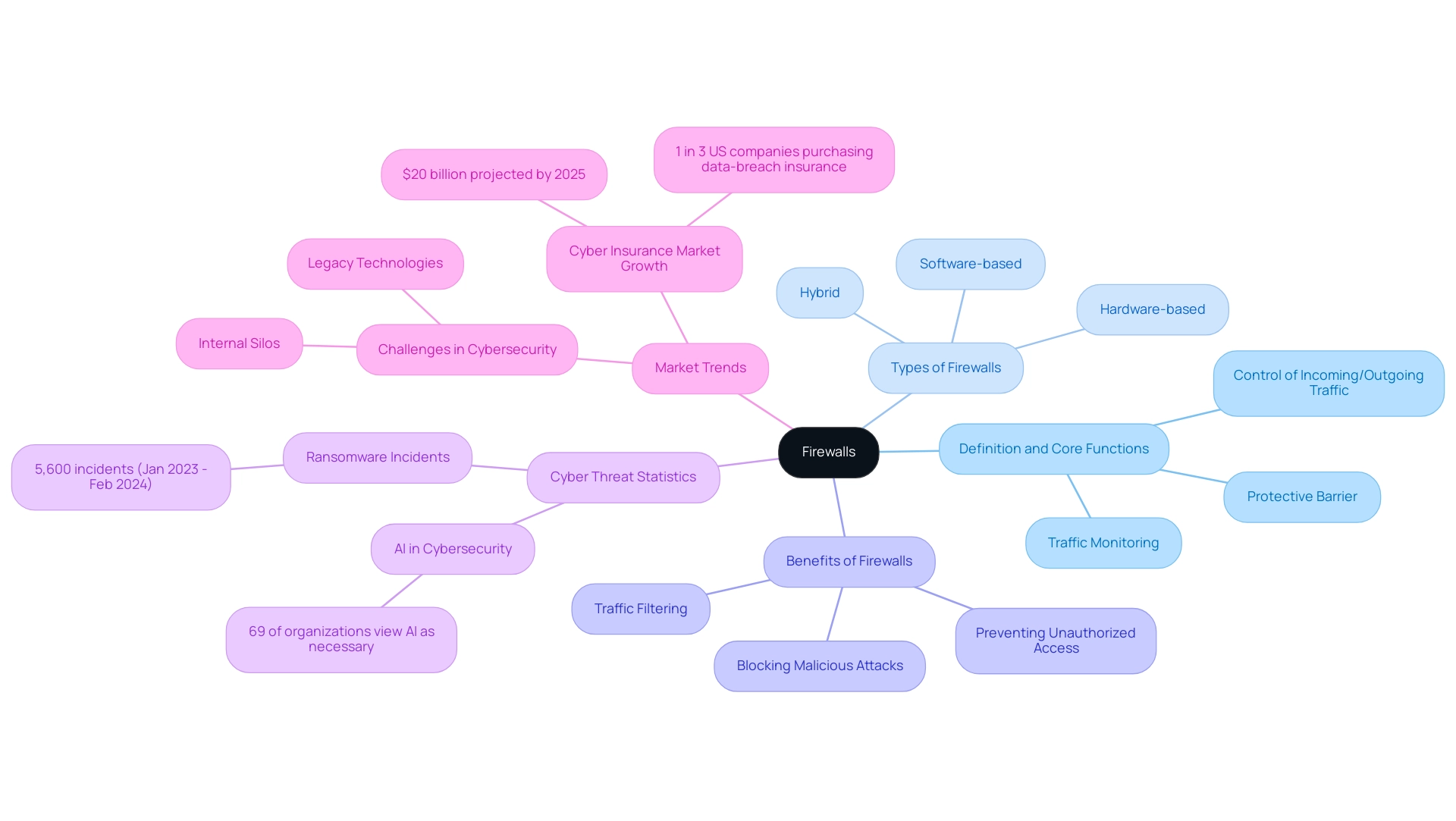
Key Benefits of Firewalls: Enhancing Security and Privacy
Firewalls are crucial elements of contemporary cybersecurity strategies, and the benefits of firewalls provide a multitude of advantages that significantly improve security. Key advantages include:
- Prevention of Unauthorized Access: Acting as guardians, these security systems effectively prevent unauthorized individuals from entering private systems, thus protecting sensitive information.
The Smart Microgrid case study exemplifies the significance of customized cybersecurity solutions, demonstrating how protective barriers can safeguard critical infrastructure from unauthorized access while preserving system performance and security.
-
Protection Against Malware: Firewalls play a pivotal role in monitoring network traffic and blocking harmful data packets, thereby defending systems against a range of malware, including viruses and worms. With recent reports indicating that up to 32% of vulnerabilities in internet-facing applications are categorized as high or critical, the necessity of strong security measures becomes evident. By preventing unauthorized access, security systems mitigate these vulnerabilities effectively.
-
Enhanced Privacy: By filtering out potentially harmful content and blocking unwanted traffic, firewalls help maintain user privacy. This is particularly important in an era where 30% of remote employees actively scan files for sensitive content, highlighting the need for stringent protective measures to safeguard personal and organizational data.
-
Network Monitoring: Firewalls provide extensive logging and alerting capabilities that enable organizations to oversee their systems for suspicious activities. This functionality enables rapid response to potential risks, a critical aspect given that a 2023 study revealed that 64% of technology professionals were unable to identify best practices for reducing phishing attacks. Barrier systems are essential in recognizing these dangers and ensuring that organizations can react efficiently.
In summary, the establishment of barriers demonstrates the benefits of firewalls, as they not only strengthen protections against unauthorized entry and malware assaults but also improve overall system visibility and user confidentiality. This renders them essential in the modern cybersecurity environment, especially as organizations encounter rising dangers and vulnerabilities.
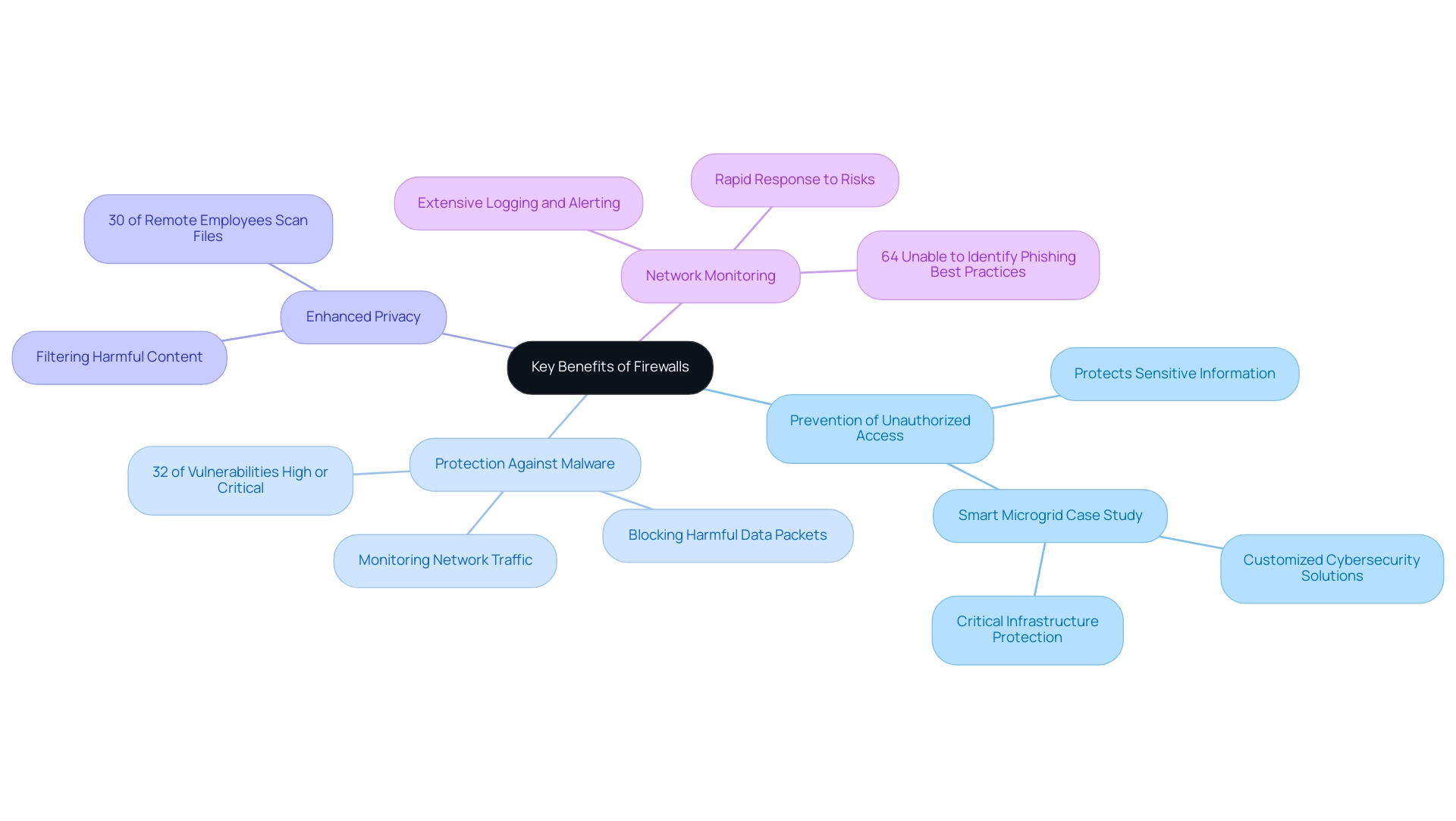
Comparing Firewall Types: Traditional vs. Next-Generation Firewalls
Traditional security systems are primarily designed to provide basic packet filtering and stateful inspection, controlling network traffic based on predefined rules. While effective for earlier protective needs, they often fall short in addressing the complexities of today’s cyber threats. In contrast, next-generation security devices (NGFWs) enhance protection through advanced capabilities such as:
- Intrusion prevention systems (IPS)
- Deep packet inspection (DPI)
- Application awareness
By conducting thorough analysis of network traffic, NGFWs can detect and categorize packets that conventional security systems might overlook, allowing for the identification and mitigation of sophisticated attacks at the application layer. This level of scrutiny is essential as cyber risks evolve. With the UK's next-generation protective system market anticipated to hit £2.5 million by 2030, it is clear that organizations are acknowledging the need to invest in stronger defense solutions.
Mert Palazoğlu, an industry analyst at AIMultiple, underscores that NGFWs not only provide enhanced protection but also offer automated threat detection and response capabilities, which are vital given the 51% of organizations reporting a 'problematic shortage' of cybersecurity skills. This shortage emphasizes the importance of deploying NGFWs, which can operate effectively with less hands-on management. Additionally, conventional barriers usually incorporate functions like:
- Standard packet filtering
- Stateful inspection
- Network address translation (NAT)
- Restricted application control
These functions are inadequate for contemporary protection requirements.
Therefore, organizations must thoroughly assess their particular protection requirements, as they can take advantage of the benefits of firewalls, with NGFWs frequently providing enhanced defense and flexibility in comparison to conventional barriers.
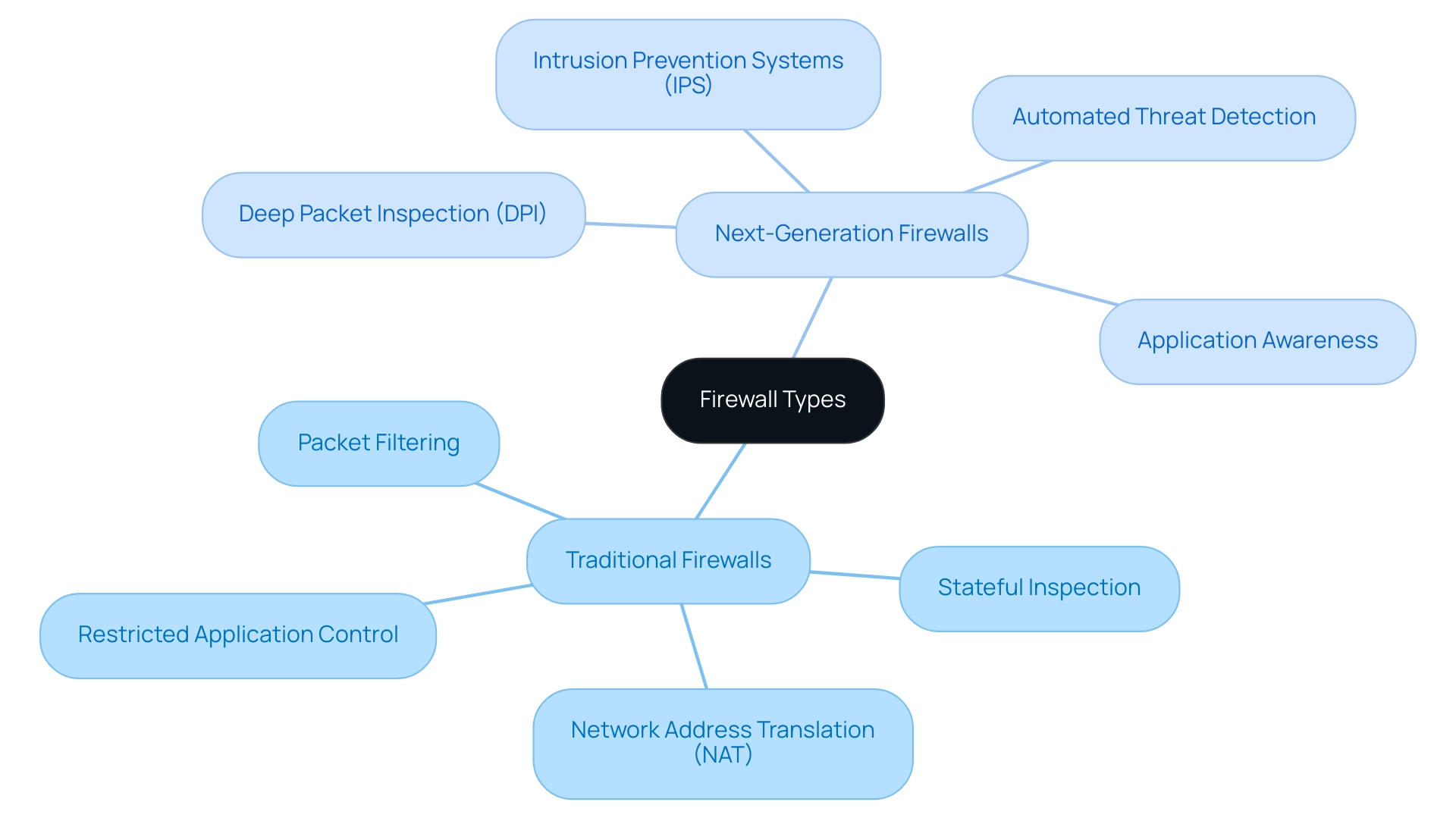
The Role of Firewalls in Business Security and Compliance
The benefits of firewalls are evident as they serve as a cornerstone of business security, effectively safeguarding sensitive data and ensuring compliance with essential regulatory standards, including GDPR, HIPAA, and PCI DSS. By creating a secure boundary, protective systems leverage the benefits of firewalls to defend against data breaches and cyberattacks, offering organizations a strong line of defense. Significantly, security systems contribute to compliance efforts by offering comprehensive logging and reporting features that document network activity, which are critical for audits and regulatory assessments.
As organizations traverse the intricacies of cybersecurity, it is essential to acknowledge that protective barriers are not just defensive instruments; they are essential elements of a comprehensive risk management approach. Current statistics indicate that global expenditure on cybersecurity is projected to reach $538.3 billion by 2030, underscoring the growing importance of investing in protective systems and cybersecurity measures. Furthermore, organizations utilizing Managed Detection and Response (MDR) services achieve a remarkable 50% reduction in Mean Time to Detect (MTTD) and Mean Time to Respond (MTTR) to incidents.
This highlights the significance of protective barriers and the benefits of firewalls in promoting a proactive stance that not only reduces risks but also improves compliance rates across enterprises in 2024. Considering recent dangers, it’s essential to recognize that over 50% of supply chain attacks are linked to prominent cyber crime organizations, illustrating the real-world risks that protective systems help reduce. Furthermore, the Target Data Breach in 2013 demonstrates the serious repercussions of insufficient security measures, where malware compromised the data of around 110 million customers, emphasizing the benefits of firewalls in preventing such incidents.
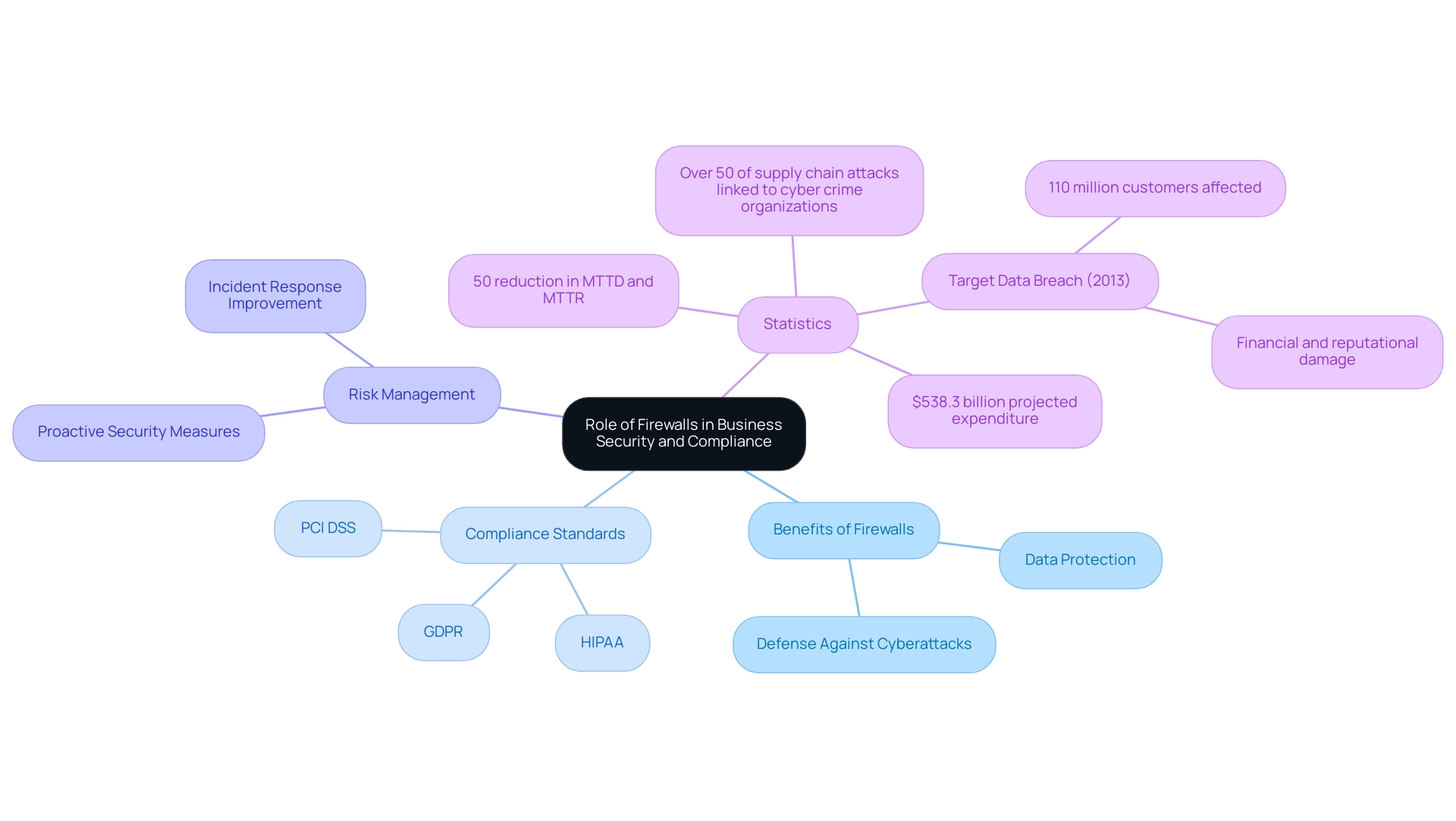
Future Trends in Firewall Technology: Adapting to New Threats
In the face of continuously evolving cyber threats, network security technology is undergoing significant transformation. Notably, cloud-based security measures have emerged as a key trend, offering organizations the flexibility and scalability necessary for effective operation in hybrid environments. As reported, the U.S. and Western Europe account for a staggering 82% of global cloud computing, underscoring the criticality of cloud infrastructure in modern security strategies.
Furthermore, as StormForge points out, most companies have reported that as their cloud spend increased, so did their cloud waste, highlighting the urgent need for improved efficiency in cloud budgets. The incorporation of artificial intelligence (AI) and machine learning (ML) into security systems is transforming hazard detection and response. These technologies empower firewalls to conduct real-time traffic analysis, highlighting the benefits of firewalls in identifying anomalies that could signify potential breaches.
Recent news indicates that AI and ML are enhancing risk detection capabilities by recognizing patterns in large data sets, facilitating rapid incident response. A study revealed that 32% of cloud budgets were reported as wasted in 2022, an increase from 30% in the previous year, illustrating the pressing need for enhanced efficiency amidst rising operational complexities. As organizations increasingly adopt these advancements, they must remain proactive in fortifying their defenses against sophisticated cyber threats.
The future of firewall technology in 2024 promises further innovations related to the benefits of firewalls, particularly in the realm of AI and ML integration, which will be crucial for enhancing security protocols and minimizing vulnerabilities. Additionally, as organizations adapt to hybrid work environments, maintaining space efficiency while managing increased staff numbers becomes a vital operational consideration.
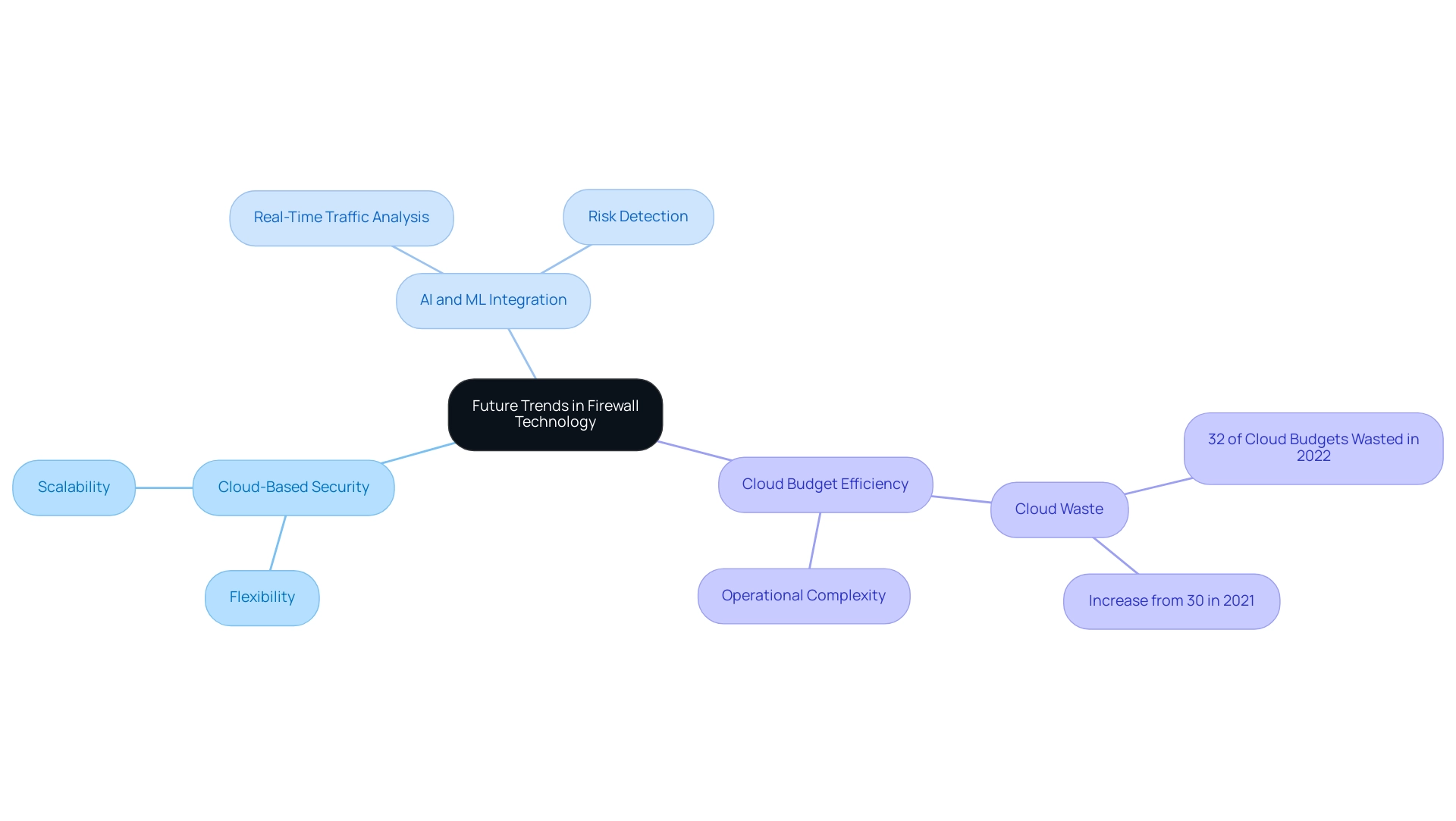
Conclusion
The pivotal role of firewalls in cybersecurity cannot be overstated. As fundamental components of network security, they effectively monitor and control traffic, preventing unauthorized access and safeguarding sensitive data from malware and other cyber threats. The evolution from traditional firewalls to next-generation firewalls highlights the necessity for organizations to adapt their security strategies to meet the complexities of modern cyber risks, ensuring that robust protections are in place.
Firewalls not only enhance security but also play a crucial role in compliance with regulatory standards. By providing comprehensive logging and monitoring capabilities, they support organizations in fulfilling their legal obligations while fostering a proactive security posture. As the landscape of cyber threats continues to evolve, the integration of advanced technologies such as artificial intelligence and machine learning into firewall systems promises to enhance threat detection and response, further fortifying defenses against sophisticated attacks.
Looking ahead, the future of firewall technology is marked by innovation and adaptation. Organizations must remain vigilant and proactive, embracing these advancements to mitigate risks effectively. As the cybersecurity landscape becomes increasingly intricate, investing in state-of-the-art firewall solutions will be essential for maintaining the integrity and security of networks, ultimately enabling businesses to navigate the digital realm with confidence.




